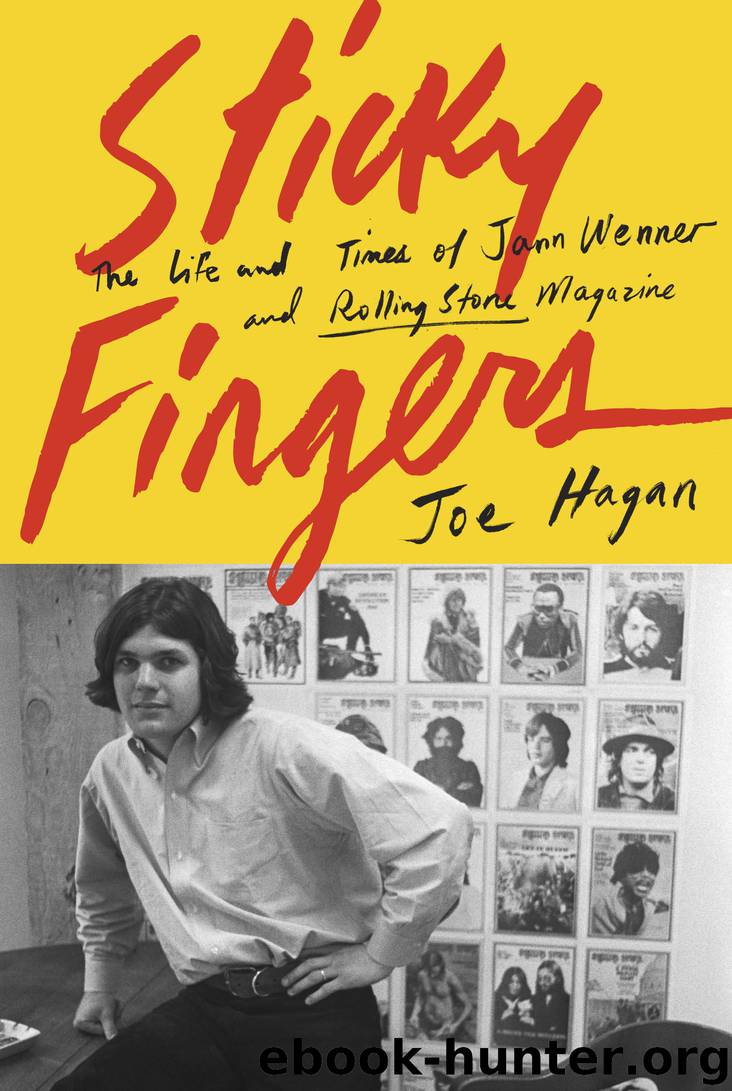Sticky Fingers by Joe Hagan

Author:Joe Hagan
Language: eng
Format: epub
Publisher: Knopf Doubleday Publishing Group
Published: 2017-10-24T04:00:00+00:00
Rader’s story concludes with Egon, in skintight pants and wilting with ennui, being informed of a secret necrophilia bar where a cadaver hangs from the ceiling and drinks are $10: “God. Boring, yes? Life is so long.”
Joe Eszterhas and Paul Scanlon rejected Rader’s story, saying it was too far afield for Rolling Stone (“Unless you gave him stock options for it, let’s kill it,” said Eszterhas). Furstenberg wouldn’t appear in the magazine until 1977, but the story was a delicious peek into a world of glamour and wealth that Wenner envied and adored and, within three years, would go marching like a glittering circus into Steve Rubell’s Studio 54.
This was the era of the “New York marriage,” in which gay men married for both friendship and social cover, including Leonard Bernstein and Felicia Montealegre, and Earl and Camilla McGrath. Egon called Diane his “best friend,” which was not unlike Jann’s feelings toward Jane. Theirs was a world where sex was as inconsequential as a handshake. “We thought we invented sexuality,” said Furstenberg. “We were the generation between the pill and AIDS. It was just a form of expression.”
The Wenners’ marriage was nowhere near as open as that of Diane and Egon, but there was nonetheless a utility to their partnership. And nothing captured that utility better than their respective relationships to Simon and Garfunkel.
While Art Garfunkel was living in San Francisco in 1971 to record his first solo album, Angel Clare, he became Jann Wenner’s friend and tennis partner. “One day we’re in the locker room,” Garfunkel said. “I’m spouting off about my quasi-political notions, my philosophy—I don’t know Jann that well, he’s never really shown his colors—and he says to me, ‘Artie, you don’t really believe that stuff, do you?’
“He pulled the rug out from under me,” he said. “Just because I am selling a million records and sitting so pretty, Jann’s not buying my philosophy easily.”
This was also a flirtation. The nature of their friendship was “sexual understanding,” said Garfunkel: a mutual interest in the open sexuality of the period. Wenner, he said, saw rock and roll through the prism of his homosexual libido. “My mind goes to Jackson Browne,” said Garfunkel. “That was a cute rocker. Jackson Browne was a quintessential star for Jann Wenner to adore, praise, and push forward.”
And so was Art Garfunkel, who appeared on the cover of Rolling Stone in October 1973. Wenner gave Ben Fong-Torres a list of questions to ask, inviting Garfunkel to air grievances with Paul Simon. Meanwhile, Wenner protected Garfunkel: After Fong-Torres interviewed him, Wenner let Garfunkel edit the manuscript and preview the photo shoot by Annie Leibovitz. Garfunkel thanked Wenner for “your deferral to my cover choice” and demanded the tapes and transcripts be destroyed. Fong-Torres was furious. He told Wenner he wished he’d removed his byline before publication. (In the next issue, Stephen Holden reviewed Garfunkel’s album as an “opulent, if somewhat overcalculated, success.”)
Conversely, Wenner’s bias against Paul Simon was now conspicuous enough that Clive Davis, his
Download
This site does not store any files on its server. We only index and link to content provided by other sites. Please contact the content providers to delete copyright contents if any and email us, we'll remove relevant links or contents immediately.
Cecilia; Or, Memoirs of an Heiress — Volume 3 by Fanny Burney(31803)
Cecilia; Or, Memoirs of an Heiress — Volume 2 by Fanny Burney(31774)
Fanny Burney by Claire Harman(26506)
We're Going to Need More Wine by Gabrielle Union(18939)
Plagued by Fire by Paul Hendrickson(17312)
All the Missing Girls by Megan Miranda(15467)
Cat's cradle by Kurt Vonnegut(15138)
Bombshells: Glamour Girls of a Lifetime by Sullivan Steve(13946)
Leonardo da Vinci by Walter Isaacson(13134)
For the Love of Europe by Rick Steves(12543)
4 3 2 1: A Novel by Paul Auster(12254)
Adultolescence by Gabbie Hanna(8826)
The remains of the day by Kazuo Ishiguro(8780)
Note to Self by Connor Franta(7602)
Diary of a Player by Brad Paisley(7445)
Giovanni's Room by James Baldwin(7152)
What Does This Button Do? by Bruce Dickinson(6119)
Ego Is the Enemy by Ryan Holiday(5262)
Born a Crime by Trevor Noah(5256)
